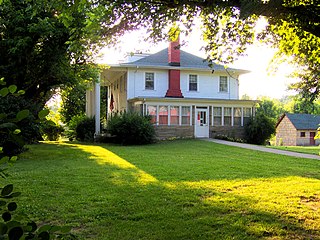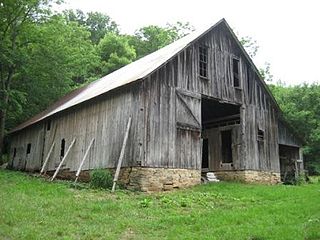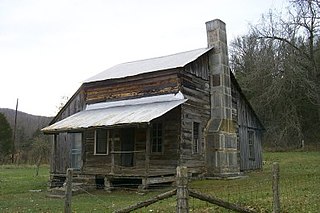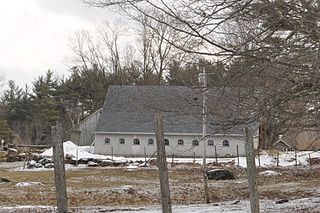
Sevierville is a city in and the county seat of Sevier County, Tennessee, United States, located in eastern Tennessee. The population was 17,889 at the 2020 United States Census.
The Farrar Distillery is a former 19th-century distillery in Noah, Tennessee, about 11 miles (18 km) north of Manchester. It is located on a family farm that dates to 1869, when Alexander Farrar purchased a tract of 103 acres (42 ha). He expanded the farm in 1875 with the acquisition of an additional 30 acres (12 ha). In addition to producing wheat, corn, small grains, and livestock on the farm, Farrar established the distillery and produced and sold corn whiskey along with and apple and peach brandies. The distillery operated until 1902, when it was closed after being damaged by flooding.

Wears Valley is an unincorporated community in Sevier County, Tennessee that was formerly treated by the U.S. Census Bureau as a census county division. As of the 2000 Census, the population of Wears Valley was 6,486.

The Oconaluftee is the valley of the Oconaluftee River in the Great Smoky Mountains of North Carolina. Formerly the site of a Cherokee village and an Appalachian community, the valley is now North Carolina's main entrance to Great Smoky Mountains National Park.

Oxon Cove Park and Oxon Cove Farm is a national historic district that includes a living farm museum operated by the National Park Service, and located at Oxon Hill, Prince George's County, Maryland. It is part of National Capital Parks-East. It was listed on the National Register of Historic Places in 2003.

Sgt. Alvin C. York State Historic Park is a state park in Pall Mall, in the U.S. state of Tennessee. Situated along the Wolf River, the park contains the farm and gristmill once owned by decorated World War I soldier Alvin C. York (1887–1964), who lived in the Pall Mall area for his entire life. Along with the millhouse and milldam, the park includes York's two-story house, York's general store and post office, the Wolf River Cemetery, the Wolf River Methodist Church, the York Bible Institute, and various picnic facilities.

Tennessee marble is a type of crystalline limestone found only in East Tennessee, in the southeastern United States. Long esteemed by architects and builders for its pinkish-gray color and the ease with which it is polished, the stone has been used in the construction of numerous notable buildings and monuments throughout the United States and Canada, including the National Gallery of Art, National Air and Space Museum, and United States Capitol in Washington, D.C., the Minnesota State Capitol, Grand Central Terminal in New York, and Union Station in Toronto. Tennessee marble achieved such popularity in the late-19th century that Knoxville, the stone's primary finishing and distribution center, became known as "The Marble City."

The Big Buffalo Valley Historic District, also known as the Boxley Valley Historic District, is notable as a cultural landscape in Buffalo National River. It comprises the Boxley Valley in northern Arkansas, near the town of Ponca. The valley includes a number of family-operated farms, primarily dating between 1870 and 1930. The farms are situated on either side of the road that parallels the river, Highway 43. Many of these farms are still operated by the descendants of the original homesteaders. However, of fifty residences in the valley, thirty were vacant in 1987, at the time of historic designation.

The Parker–Hickman Farm includes the oldest standing log structure in Buffalo National River. The farm was homesteaded in the 1840s by settlers from Tennessee. It embodies an agricultural landscape with farmstead, extant fields, fencerows, roads, cattle gates, garden and orchard plots, wooded slopes and springs. Unlike most farms in the Ozarks the landscape is remarkably intact and provides insights and evidence spanning portions of two centuries of Ozark history; not randomly chosen, it conveys a feeling of enclosure and exemplifies adaptive use of topography. Among farms of its kind in Missouri and Arkansas it was once typical but now survives as a rare baseline example for Ozark yeomanry farms of mixed economies. Parker–Hickman was an agricultural enterprise that continuously operated until 1982 from a farmstead which exemplifies the entire period, and a rare one for the Ozarks since it survives. Clustered around the farmstead are several structures: barns, sheds smokehouse, privy, fences, stock feeders and house that represent a cross-section of rural vernacular architecture still in their original location.
This is a list of the National Register of Historic Places listings in Blount County, Tennessee.
This is a list of the National Register of Historic Places listings in Williamson County, Tennessee.
Smithson–McCall Farm is a 256.3-acre (103.7 ha) historic district in Bethesda, Tennessee. The farm was listed under the National Register of Historic Places in 2007. The listing claims that the property "documents the impact of the progressive agricultural movement of the early twentieth century on the operations and landscape of a middle-class family farm," and includes an "architecturally significant group of buildings and structures, placed within an agricultural landscape of high integrity...that represents a good example of farmstead architecture in Middle Tennessee and that reflects the impact of the Progressive Farm movement of the early twentieth century".

The Boyd–Wilson Farm is a 157-acre (64 ha) historic district in Franklin, Tennessee, United States. The circa 1840 farm includes an I-house.

Harlinsdale Farm is a 198-acre (80 ha) historic district in Franklin, Tennessee that was listed on the National Register of Historic Places in 2006. It dates from c.1900 and had other significant dates in 1935 and 1945.

The Frost Farm is a historic farmstead on Korpi Road in Dublin, New Hampshire. It includes a farmhouse built in 1806 and subsequently enlarged, and a renovated 19th-century barn. The property is significant for its architecture, and for its ownership by both early settlers and later Finnish immigrants. A portion of the property was listed on the National Register of Historic Places in 1983.

The Silver Lake Farm is a historic farmstead on Seaver Road in northwestern Harrisville, New Hampshire. Established about 1820, it was a highly successful local farm, serving first businesses as far off as Keene, and then the local summer resort trade at nearby Silver Lake. The house is relatively little-altered despite intensive use into the 20th century. The farmstead was listed on the National Register of Historic Places in 1988.

The Stone Farm is a historic farmhouse on Old Marlborough Road in Dublin, New Hampshire. Built about 1806 with several 19th-century alterations, it is a well-preserved example of a period farmhouse. The property was listed on the National Register of Historic Places in 1983.
The Robertson Family Farm, in or near Whiteville, Tennessee, was listed on the National Register of Historic Places in 2007. It then included four contributing buildings and a contributing site.
The Maple Dean Farm is a historic farmhouse in Shelbyville, Tennessee, U.S.. Built in 1886 on a farm established in 1819, it was designed in the Eastlake architectural style. It became a century farm in 1976, and it was listed on the National Register of Historic Places in 1976.

Wessyngton is a historic mansion on a former tobacco plantation in Cedar Hill, Tennessee, U.S. It is listed on the National Register of Historic Places.















